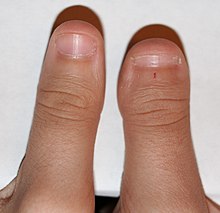Racquet nail
| Racquet nail | |
|---|---|
 | |
| Brachyonychia in Brachydactyly type D | |
| Specialty | Dermatology |
In racquet nails (also known as brachyonychia,[1] nail en raquette,[2] and racquet thumb[1]), the nail plate is flattened, the end of the thumb is widened and flattened, and the distal phalanx is abnormally short.[2]: 786 In racquet nails, the width of the nail bed and nail plate is greater than their length.[3]: 657 The condition is painless and asymptomatic.
Racquet nails usually occur on one or both thumbs, but may appear on all fingers and toes. It may be genetic, inherited as an autosomal-dominant trait,[2]: 786 or acquired. Genetic disorders associated with racquet nail include Larsen syndrome, Brooke–Spiegler syndrome, Rubinstein–Taybi syndrome, Hajdu–Cheney syndrome, cartilage–hair hypoplasia, pycnodysostosis, acrodysostosis, and brachydactyly type D.[4]
Acquired racquet nail is associated with acroosteolysis and psoriatic arthropathy.[4] Acquired racquet nail may also be diagnostic of bone resorption in hyperparathyroidism.[5]
Racquet nail often presents with other nail conditions such as onycholysis, koilonychia, pachyonychia, Muehrcke's lines, leuconychia, and half-and-half nails.[5] Cosmetic surgery can be used to improve the appearance of the nails.[4]
See also[edit]
References[edit]
- ^ a b Rapini, Ronald P.; Bolognia, Jean L.; Jorizzo, Joseph L. (2007). Dermatology: 2-Volume Set. St. Louis: Mosby. ISBN 978-1-4160-2999-1.
- ^ a b c James, William; Berger, Timothy; Elston, Dirk (2005). Andrews' Diseases of the Skin: Clinical Dermatology. (10th ed.). Saunders. ISBN 0-7216-2921-0.
- ^ Freedberg, et al. (2003). Fitzpatrick's Dermatology in General Medicine. (6th ed.). McGraw-Hill. ISBN 0-07-138076-0.
- ^ a b c Baran, Robert; de Berker, David; Holzberg, Mark; Thomas, Luc (July 23, 2012). Baran and Dawber's Diseases of the Nails and their Management (4th ed.). Wiley-Blackwell. ISBN 978-0470657355. Retrieved 27 June 2014.
- ^ a b Baran, R.; Turkmani, M.G.; Mubki, T. (2014). "Acquired Racquet Nails: a Useful Sign of Hyperparathyroidism". Journal of the European Academy of Dermatology and Venereology. 28 (2): 257–259. doi:10.1111/jdv.12187. PMID 23682576. S2CID 23151745.
